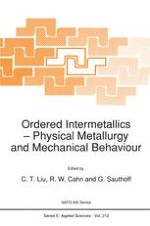1992 | OriginalPaper | Chapter
Observations of Dislocation Mechanisms Governing Yield Strength in L12 Alloys
Authors : Y. Q. Sun, P. M. Hazzledine
Published in: Ordered Intermetallics — Physical Metallurgy and Mechanical Behaviour
Publisher: Springer Netherlands
Included in: Professional Book Archive
Activate our intelligent search to find suitable subject content or patents.
Select sections of text to find matching patents with Artificial Intelligence. powered by
Select sections of text to find additional relevant content using AI-assisted search. powered by
The structures and properties of dislocations and other defects in deformed L12 ordered Ni3Al and Ni3Ga are observed with transmission electron microscopy. The principal intention of this paper is to examine the changes in the structure and behaviour of dislocations in a wide temperature range (-196 to 900 C) with a view to understanding the transitions of slip systems and yielding properties. Dislocations with low mobilities in the various temperature regions are first identified with weak-beam microscopy and the core structure of these dislocations are then observed directly by lattice resolution TEM. In order of increasing temperature, dislocations observed to have non-planar structures are: 30° >112</3 super-Shockley partials (Giamei locks), screw >101< superdislocations (Kear-Wilsdorf locks), edge >101<(001) superdislocations (Lomer-Cottrell type locks), and 45° >100<(001) dislocations (B5 locks). The effects of temperature on the formation and destruction of these locks are discussed and related to the transition of slip systems and the change of yield properties. The operation of a kink mechanism for the unlocking of Kear-Wilsdorf locks is shown to lead to the formation of special kink configurations with switched partials and the formation of antiphase domain boundary tubes which are also observed to characterize the region of the yield stress anomaly.
